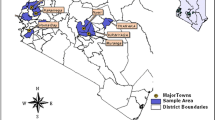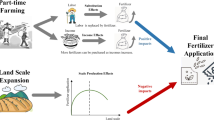Abstract
Sub-Saharan Africa faces huge food supply challenges due to increasing human population, limited opportunities to increase arable land, and declining yields associated with continuously declining soil fertility. To cater for their food requirements, smallholders use only modest levels of inorganic fertilizers and rely to a large extent on manure, which is generally of low quality. To explore factors influencing fertilizer and manure use at the farm level, 253 farm households in Vihiga district of western Kenya were sampled. A pair of Tobit models was used to relate amounts of manure and fertilizer used to household variables. The results indicate that the use of both manure and fertilizer reciprocally influence each other and are strongly influenced by household factors, and also imply that manure and fertilizer uses are endogenous. Policy changes are required to (1) reduce the burden on farming alone in rural areas; (2) promote the use of higher-cost, higher-value inputs such as fertilizers; (3) improve access to input and output markets; and (4) encourage farmer education so as to promote sustainable soil fertility management. Improved understanding of the biophysical and socioeconomic environment of smallholder systems can help target sustainable soil fertility interventions more appropriately.
Similar content being viewed by others
Notes
This is the most devastating form of soil degradation in sub-Saharan Africa but may also be closely associated with soil erosion.
“Fertilizer” in this paper represents inorganic fertilizer.
Tropical livestock unit gives an adult male cow a value of 1, adult female 0.7, weaners 0.5 and pre-weaners 0.2 (Janhke, 1982)
This classification, based on available natural resource base, dominant pattern of farm activities and household livelihoods, defines eight distinct systems. Thorne et al. (2003) break down this system by scale of production and intensity of livestock production.
1 US$ is equivalent to Kenya Shillings 72 (September 2006)
References
Adesina AA, Baidu-Forson J (1995) Farmers’ perceptions and adoption of new agricultural technology: evidence from analysis in Burkina Faso and Guinea, West Africa. Agric Econ 13:1–9
Adesina AA, Zinnah MM (1993) Technology characteristics, farmers’ perspectives and adoption decisions: a Tobit model application in Sierra Leone. Agric Econ 9:297–311
Badiane O, Delgado CL (1995) A 2020 vision for food, agriculture and the environment in sub-Saharan Africa. Food, agric. and the Environ. Discussion Paper 4. International Food Policy Research Institute (IFPRI), Washington DC, USA
Booltink HWG, Thornton PK, Waithaka MM, Shepherd KD, Jones JW (1999) System prototyping and impact assessment for sustainable alternatives in mixed farming systems in high-potential areas of Eastern Africa. A proposal to the Ecoregional Fund to Support Methodological Initiatives. Wageningen University, The Netherlands. http://www.cgiar.org/ilri/prosam
Central Bureau of Statistics (2001) 1999 Population and housing census. Counting our people for development. Vol. I Population distribution by administrative areas and urban centers and Vol. II Socio-economic profile of the population. Central Bureau of Statistics, Ministry of Finance and Planning, Nairobi, Kenya
Crowley EL, Soule MJ, Carter SE (1996) Off-farm income and farming in western Kenya. Report to USAID/Kenya, Nairobi
De Jager A, Kariuki I, Matiri FM, Odendo M, Wanyama JM (1998) Linking economic performance and nutrient balances in different farming systems in Kenya: a synthesis towards an integrated analysis of economic and ecological sustainability. Agric Ecosyst Environ 71:81–92
Ehui S, Pender J (2005) Resource degradation, low agricultural productivity, and poverty ijn sub-Saharan Africa: pathways out of the spiral. In: Colman D, Vink N (eds) Reshaping agriculture’s contributions to society. Proceedings of the 25th International Conference of Agricultural Economists 16–22 August, 2003 Durban, South Africa. Blackwell Publishing, pp 225–242
Freeman AH, Omiti JM (2003) Fertilizer use in semi-arid areas of Kenya: analysis of smallholder farmers’ adoption behaviour under liberalized markets. Nutr Cycl Agroecosys 66:23–31
Greene WH (2000) Econometric analysis. 4th edn. Prentice-Hall, Inc., Upper Saddle River, New Jersey
Hall M, Dixon J, Gulliver A, Gibbon D (eds) (2001) Farming systems and poverty. Improving farmers’ livelihoods in a changing world. FAO and World Bank, Rome and Washington D.C
Heisey PW, Mwangi W (1996) Fertilizer use and maize production in Sub-Saharan Africa. CIMMYT Economics Working Paper 96-01. CIMMYT, Mexico, DP
Jaetzold R, Schmidt H (1983) Farm management handbook of Kenya, vol 1. Nairobi
Janhke HE (1982) Livestock production and livestock development in tropical Africa. Weltforum Verlag, Munich
Jayne TS, Govereh J, Wanzala M, Demeke M (2003) Fertilizer market development: a comparative analysis of Ethiopia, Kenya, and Zambia. Food Policy 28:293–316
Lekasi JK, Tanner JC, Kimani SK, Harris PJC (2003) Cattle manure quality in Maragua district, central Kenya: effect of management practices and development of simple methods of assessment. Agric Ecosyst Environ 94:289–298
Makokha S, Kimani S, Mwangi W, Verkuijl H, Musembi F (2001) Determinants of fertilizer and manure use in maize production in Kiambu district, Kenya. International Maize and Wheat Improvement center (CIMMYT) and Kenya Agricultural Research Institute (KARI), Mexico DF
Ministry of Agriculture 1994–2000. Annual report. Nairobi, Kenya
MSU, (1999a) Successes and challenges of food market reform: experiences from Kenya, Zambia and Zimbabwe. In: International Development Working Paper No. 72 Department of Agricultural Economics, Michigan State University (MSU), East Lansing, MI
MSU (1999b) Effects of agricultural commercialization on food crop input use and productivity in Kenya. In: International Development Working Paper No. 71 Department of Agricultural Economics, Michigan State University (MSU), East Lansing, MI
MSU (1998) Incentives for fertilizer use in sub-Saharan Africa: a review of empirical evidence on fertilizer response and profitability. In International Development Working Paper No. 70 Department of Agricultural Economics, Michigan State University (MSU), East Lansing, MI
Mugunieri GL, Nyangito HO, Mose LO (1997) Agronomic and socio-economic factors determining maize yield response to fertilizers in western Kenya. In: Adipala E, Tenywa JS, Ogenga-Latigo MW (eds) African crop science conference proceedings. Pretoria, 13–17 January 1991 pp 1465–71
Omamo SW, Williams JC, Obare GA, Ndiwa NN (2002) Soil fertility management on small farms in Africa: evidence from Nakuru district, Kenya. Food Policy 27:159–170
Omamo SW, Mose LO (2001) Fertilizer trade under market liberalization: preliminary evidence from Kenya. Food Policy 26:1–10
Palm CA, Myers RJK, Nandwa SM (1997) Combined use of organic and inorganic nutrient sources for soil fertility maintenance and replenishment. In: Buresh RJ, Sanchez PA, Calhoun F (eds) Replenishing soil fertility in Africa. Soil Science Society of America, Madison, Wisconsin
Place F, Barrett CB, Freeman HA, Ramisch JJ, Vanlauwe B (2003) Prospects for integrated soil fertility management using organic and inorganic inputs: evidence from smallholder African agricultural systems. Food Policy 28:365–378
Rahm MR, Huffman WE (1984) The adoption of reduced tillage: the role of human capital and other variables. American Journal of Agricultural Economics 66:405–413
Salasya BDS (2005) Crop production and soil nutrient management: an economic analysis of households in western and central Kenya. PhD Thesis, Development Economics Group, Wageningen University, The Netherlands
Sanchez PA, Shepherd KD, Soule MJ, Place FM, Buresh RJ Izac A-MN, Mokwunye AU, Kwesiga FR Ndiritu CG, Woomer PL (1997) Soil Fertility Replenishment in Africa: An Investment in Natural Resource Capital. In: Buresh RJ, Sanchez PA, Calhoun F (eds) Replenishing Soil Fertility in Africa. Soil Science Society of America, Madison, Wisconsin
Shepherd KD, Soule MJ (1998) Soil fertility management in west Kenya: dynamic simulation of productivity, profitability and sustainability at different resource endowment levels. Agric Ecosyst Environ 71: 131–145
Shepherd KD, Ohlsson E, Okalebo JR, Ndufa JK, David S (1995) A static model of nutrient flow on mixed farms in the highlands of western Kenya to explore the possible impact of improved management. In: JM Powell, Fernandez-Rivera S, Williams TO, Renard C (eds) Livestock and sustainable nutrient cycling in mixed farming systems in sub-Saharan Africa. Proceedings of an international conference, 22–26 November 1993, held at the International Livestock Centre for Africa, Addis Ababa, Ethiopia. ILCA, Addis Ababa, pp 523–538
Staal SJ, Owango M, Muriuki H, Kenyanjui M, Lukuyu B, Njoroge L, Njubi D, Baltenweck I, Musembi F, Bwana O, Muriuki K, Gichungu G, Omore A, Thorpe W (2000) Dairy systems characterisation of the greater Nairobi milk shed. MoARD/KARI/ILRI Collaborative Research Report, Smallholder Dairy (R&D) Project, Nairobi, Kenya
Thorne PJ, Thornton PK, Kruska RL, Reynolds L, Waddington SR, Rutherford AS, Odero AN (2003) Maize as food, feed and fertilizer in intensifying crop-livestock systems in East and southern Africa: an ex ante impact assessment of technology interventions to improve smallholder welfare. ILRI Impact Assessment Series 11. ILRI (International Livestock Research Institute), Nairobi, Kenya. 123 pp
Thornton PK, Kruska RL, Henninger N, Kristjanson PM, Reid RS, Atieno F, Odero A, Ndegwa T (2002) Mapping poverty and livestock in the developing world. ILRI (International Livestock Research Institute), Nairobi, Kenya, 124 pp
Waithaka MM, Thornton PK, Shepherd KD, Herrero M (2006) Bio-economic evaluation of farmers’ perceptions of viable farms in western Kenya. Agricultural Systems 90:243–271
Waithaka MM, Nyangaga JN, Wokabi A, Muriuki K, Staal SJ, Njoroge L, Njubi D (2002) Characterization of dairy systems in the western Kenya region. Smallholder Dairy (Research & Development) Project Report, Ministry of Agriculture and Rural Development, Kenya Agricultural Research Institute and the International Livestock Research Institute. Nairobi, Kenya
Acknowledgements
This research was supported in part by the Ecoregional Fund to Support Methodological Initiatives of the Dutch Government, to whom we are grateful. This work was carried out when the first author was a researcher at the International Livestock Research Institute, Nairobi, Kenya.
Author information
Authors and Affiliations
Corresponding author
Rights and permissions
About this article
Cite this article
Waithaka, M.M., Thornton, P.K., Shepherd, K.D. et al. Factors affecting the use of fertilizers and manure by smallholders: the case of Vihiga, western Kenya. Nutr Cycl Agroecosyst 78, 211–224 (2007). https://doi.org/10.1007/s10705-006-9087-x
Received:
Accepted:
Published:
Issue Date:
DOI: https://doi.org/10.1007/s10705-006-9087-x




